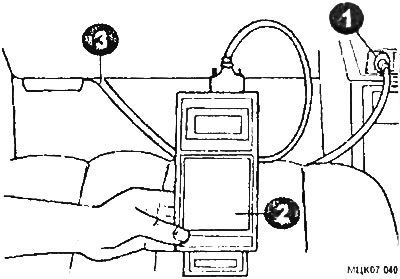WARNING: When performing certain test procedures, it may be that additional fault codes will be issued. You need to be careful that the codes issued during the checks do not mislead the inspector.
Connect the trouble code reader (2) to the self-diagnosis plug (3).
Supply power to the device from the cigarette lighter (1).

Use the trouble code reader for the following purposes in strict accordance with the device manufacturer's instructions:
- reading fault codes;
- erasing fault codes.
After checking the parts, as well as after repairs that include the removal or replacement of parts of the engine management system, you should always erase the codes.
Use a DTC reader to interrogate the ECM for DTCs, or read the codes manually as described above.
There are codes in memory
If one or more fault codes are found, refer to the tables below to determine the meaning of the fault code.
If multiple codes are issued, look for a common symptom, such as a power or ground fault.
When the problem is fixed, clear the codes and run the engine under various conditions to see if the problem is gone.
1Check the electronic control module for trouble codes again. Repeat the above procedures if the codes still persist.
No codes in memory
When there are problems during engine operation, but there are no codes in the memory of the electronic control module, then the malfunction is not included in the parameters provided by the self-diagnosis system.
If the symptoms point to a specific part, replace the defective part with a good one.
